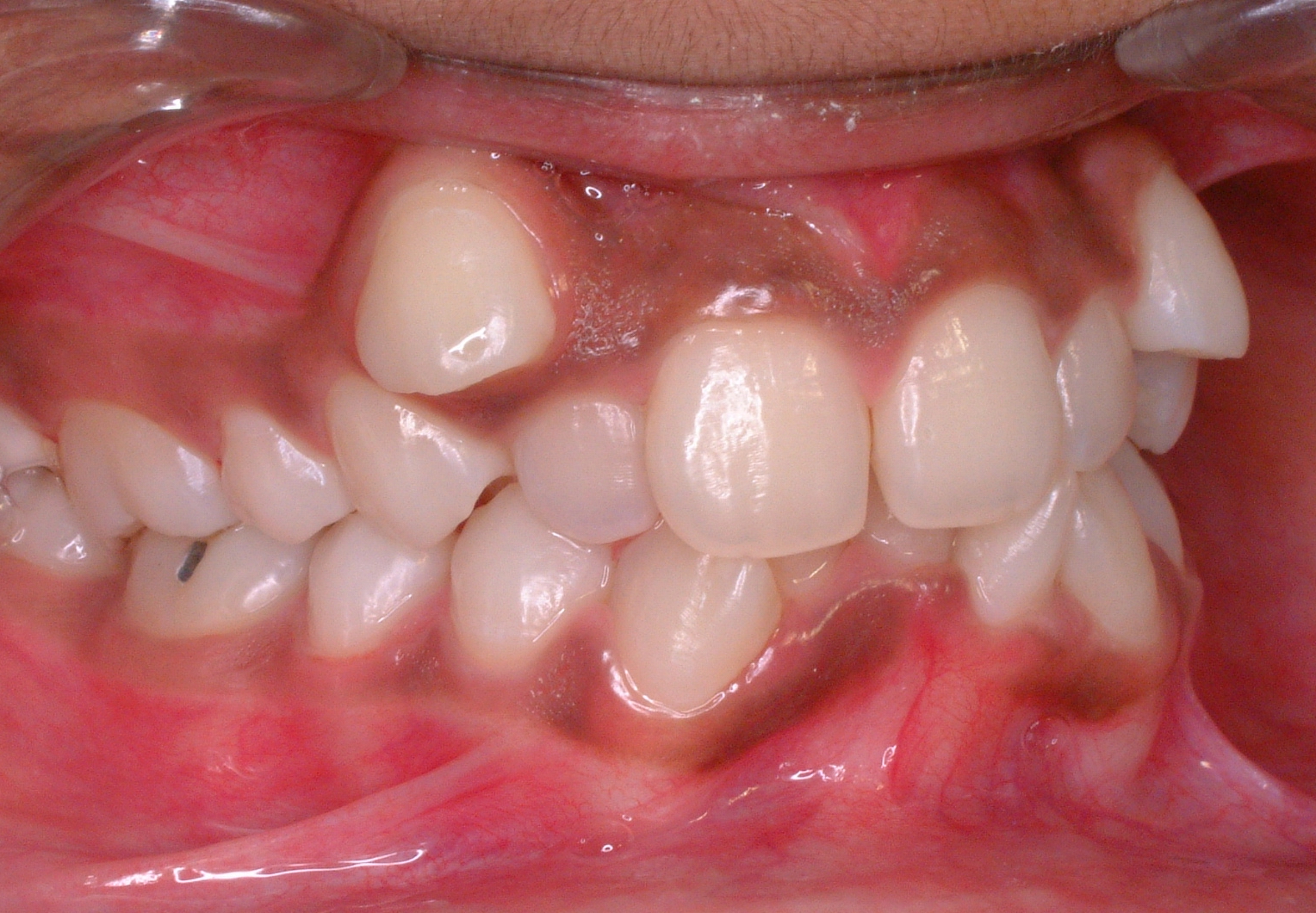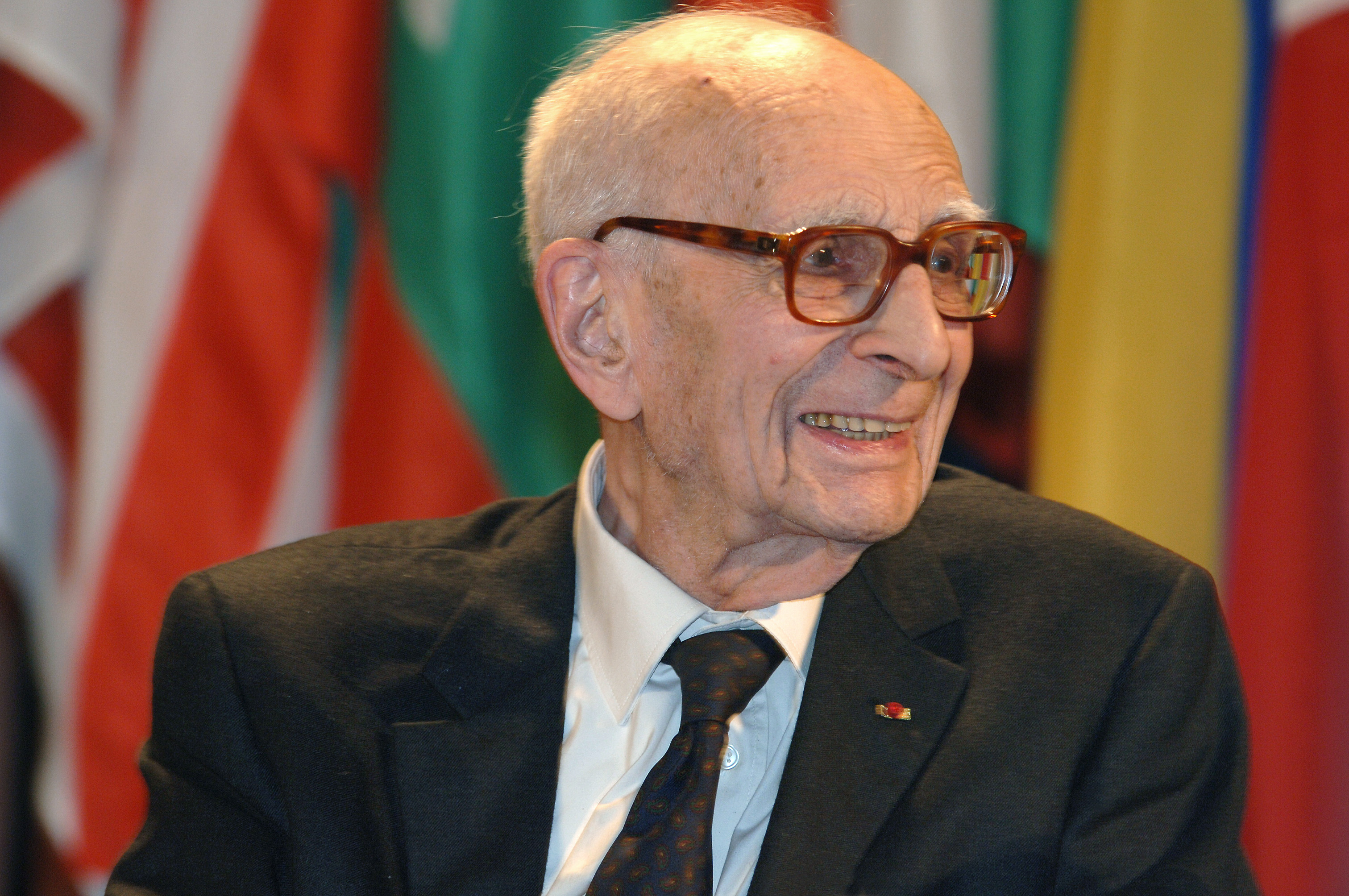|
Overbite
Overbite is the extent of vertical ( superior-inferior) overlap of the maxillary central incisors over the mandibular central incisors, measured relative to the incisal ridges. The term overbite does not refer to a specific condition, nor is it a form of malocclusion. Rather an absent or excess overbite would be a malocclusion. Normal overbite is not measured in exact terms, but as a proportion (approximately 30–50% of the height of the mandibular incisors) and is commonly expressed as a percentage. Other terms confused with "overbite" Overbite is often confused with overjet, which is the distance between the maxillary anterior teeth and the mandibular anterior teeth in the anterior-posterior axis. "Overbite" may also be used commonly to refer to Class II malocclusion or retrognathia, though this usage can be considered incorrect. This is where the mesiobuccal cusp of the maxillary first molar is situated anterior to the buccal groove of the mandibular first molar; ... [...More Info...] [...Related Items...] OR: [Wikipedia] [Google] [Baidu] |
Overjet
In dentistry, overjet is the extent of horizontal ( anterior-posterior) overlap of the maxillary central incisors over the mandibular central incisors. In class II (division I) malocclusion the overjet is increased as the maxillary central incisors are protruded. Class II Division I is an incisal classification of malocclusion where the incisal edge of the mandibular incisors lie posterior to the cingulum plateau of the maxillary incisors with normal or proclined maxillary incisors (British Standards Index, 1983). There is always an associated increase in overjet. In the Class II Division 2 incisal classification of malocclusion, the lower incisors occlude posterior to the cingulum plateau of the upper incisors and the upper central incisors are retroclined. The overjet is usually minimal but it may be increased. Signs and symptoms Class II Div I :Benefits associated with orthodontic treatment include a reduction in the susceptibility to caries, periodontal disease and tempor ... [...More Info...] [...Related Items...] OR: [Wikipedia] [Google] [Baidu] |
Malocclusion
In orthodontics, a malocclusion is a misalignment or incorrect relation between the teeth of the upper and lower dental arches when they approach each other as the jaws close. The English-language term dates from 1864; Edward Angle (1855–1930), the "father of modern orthodontics", popularised it. The word derives . The malocclusion classification is based on the relationship of the mesiobuccal cusp of the maxillary first molar and the buccal groove of the mandibular first molar. If this molar relationship exists, then the teeth can align into normal occlusion. According to Angle, malocclusion is any deviation of the occlusion from the ideal. However, assessment for malocclusion should also take into account aesthetics and the impact on functionality. If these aspects are acceptable to the patient despite meeting the formal definition of malocclusion, then treatment may not be necessary. It is estimated that nearly 30% of the population have malocclusions that are cat ... [...More Info...] [...Related Items...] OR: [Wikipedia] [Google] [Baidu] |
Deep Bite
In orthodontics, a malocclusion is a misalignment or incorrect relation between the teeth of the upper and lower dental arches when they approach each other as the jaws close. The English-language term dates from 1864; Edward Angle (1855–1930), the "father of modern orthodontics", popularised it. The word derives . The malocclusion classification is based on the relationship of the mesiobuccal cusp of the maxillary first molar and the buccal groove of the mandibular first molar. If this molar relationship exists, then the teeth can align into normal occlusion. According to Angle, malocclusion is any deviation of the occlusion from the ideal. However, assessment for malocclusion should also take into account aesthetics and the impact on functionality. If these aspects are acceptable to the patient despite meeting the formal definition of malocclusion, then treatment may not be necessary. It is estimated that nearly 30% of the population have malocclusions that are categori ... [...More Info...] [...Related Items...] OR: [Wikipedia] [Google] [Baidu] |
Cutlery
Cutlery (also referred to as silverware, flatware, or tableware) includes any hand implement used in preparing, serving, and especially eating food in Western culture. A person who makes or sells cutlery is called a cutler. While most cutlers were historically men, women could be cutlers too; Agnes Cotiller was working as a cutler in London in 1346, and training a woman apprentice, known as Juseana. The city of Sheffield in England has been famous for the production of cutlery since the 17th century and a train – the ''Master Cutler'' – running from Sheffield to London was named after the industry. Bringing affordable cutlery to the masses, stainless steel was developed in Sheffield in the early 20th century. The major items of cutlery in Western culture are the knife, fork and spoon. These three implements first appeared together on tables in Britain in the Georgian era. In recent times, hybrid versions of cutlery have been made combining the functionality of differe ... [...More Info...] [...Related Items...] OR: [Wikipedia] [Google] [Baidu] |
The Conversation (website)
''The Conversation'' is a network of nonprofit media outlets publishing news stories and research reports online, authored by academics with professional journalist editors to produce accessible research-informed outputs. Articles are written by academics and researchers under a Creative Commons license, allowing reuse without modification. Copyright terms for images are generally listed in the image caption and attribution. Its model has been described as explanatory journalism. Except in "exceptional circumstances", it only publishes articles by "academics employed by, or otherwise formally connected to, accredited institutions, including universities and accredited research bodies". The website was launched in Australia in March 2011. The network has since expanded globally with a variety of local editions originating from around the world. In September 2019, ''The Conversation'' reported a monthly online audience of 10.7 million users, and a combined reach o ... [...More Info...] [...Related Items...] OR: [Wikipedia] [Google] [Baidu] |
Labiodental Consonant
In phonetics, labiodentals are consonants articulated with the lower lip and the upper teeth, such as and . In English, labiodentalized /s/, /z/ and /r/ are characteristic of some individuals; these may be written . Labiodental consonants in the IPA The labiodental consonants identified by the International Phonetic Alphabet are: The IPA chart shades out ''labiodental lateral consonants''. This is sometimes read as indicating that such sounds are not possible. In fact, the fricatives and often have lateral airflow, but no language makes a distinction for centrality, and the allophony is not noticeable. The IPA symbol refers to a sound occurring in Swedish, officially described as similar to the velar fricative but one dialectal variant is a rounded, velarized labiodental, less ambiguously rendered as . The labiodental click is an allophonic variant of the (bi)labial click. Occurrence The only common labiodental sounds to occur phonemically are the fricatives and th ... [...More Info...] [...Related Items...] OR: [Wikipedia] [Google] [Baidu] |
Chopsticks
Chopsticks are shaped pairs of equal-length sticks that have been used as kitchen and eating utensils in most of East Asia for over three millennia. They are held in the dominant hand, secured by fingers, and wielded as extensions of the hand, to pick up food. Originating in China, chopsticks later spread to other parts of continental Asia. Chopsticks have become more accepted in connection with East Asian food in the West, especially in cities with significant East Asian diaspora communities. The use of chopsticks has also spread to the rest of Southeast Asia either via the Chinese diaspora or through some dishes such as noodles that may require chopsticks. Chopsticks are smoothed, and frequently tapered. They are traditionally made of wood, bamboo, metal, ivory, and ceramics, and in modern days, increasingly available in non-traditional materials such as plastic, stainless steel, and even titanium. Chopsticks are often seen as requiring practice and skill to master to be ... [...More Info...] [...Related Items...] OR: [Wikipedia] [Google] [Baidu] |
Chinese People
The Chinese people, or simply Chinese, are people or ethnic groups identified with Greater China, China, usually through ethnicity, nationality, citizenship, or other affiliation. Chinese people are known as Zhongguoren () or as Huaren () by speakers of standard Chinese, including those living in Greater China as well as overseas Chinese. Although both terms both refer to Chinese people, their usage depends on the person and context. The former term is commonly (but not exclusively) used to refer to the citizens of the People's Republic of China—especially mainland China. The term Huaren is used to refer to ethnic Chinese, and is more often used for those who reside overseas or are non-citizens of China. The Han Chinese are the largest ethnic group in China, comprising approximately 92% of its Mainland China, Mainland population. [...More Info...] [...Related Items...] OR: [Wikipedia] [Google] [Baidu] |
Anthropologist
An anthropologist is a scientist engaged in the practice of anthropology. Anthropologists study aspects of humans within past and present societies. Social anthropology, cultural anthropology and philosophical anthropology study the norms, values, and general behavior of societies. Linguistic anthropology studies how language affects social life, while economic anthropology studies human economic behavior. Biological (physical), forensic, and medical anthropology study the biology and evolution of humans and their primate relatives, the application of biological anthropology in a legal setting, and the study of diseases and their impacts on humans over time, respectively. Education Anthropologists usually cover a breadth of topics within anthropology in their undergraduate education and then proceed to specialize in topics of their own choice at the graduate level. In some universities, a qualifying exam serves to test both the breadth and depth of a student's understandi ... [...More Info...] [...Related Items...] OR: [Wikipedia] [Google] [Baidu] |
Fork
In cutlery or kitchenware, a fork (from 'pitchfork') is a utensil, now usually made of metal, whose long handle terminates in a head that branches into several narrow and often slightly curved tines with which one can spear foods either to hold them to cut with a knife or to lift them to the mouth. History Bone forks have been found in archaeological sites of the Bronze Age Qijia culture (2400–1900 BC), the Shang dynasty (c. 1600–c. 1050 BC), as well as later Chinese dynasties.Needham (2000). ''Science and Civilisation in China. Volume 6: Biology and biological technology. Part V: Fermentations and food science.'' Cambridge University Press. Pages 105–110. A stone carving from an Eastern Han tomb (in Ta-kua-liang, Suide County, Shaanxi) depicts three hanging two-pronged forks in a dining scene. Similar forks have also been depicted on top of a stove in a scene at another Eastern Han tomb (in Suide County, Shaanxi). In Ancient Egypt, large forks were used as cooking ut ... [...More Info...] [...Related Items...] OR: [Wikipedia] [Google] [Baidu] |
Table Knife
A table knife is an item of cutlery with a single cutting edge, and a blunt end – part of a table setting. Table knives are typically of moderate sharpness only, designed to cut prepared and cooked food. History In early periods in the West, no special kind of knife was used at the table. Men and often women from all classes carried a knife around with them for a great variety of tasks, from pruning trees to personal protection or eating at table. The Anglo-Saxon and Germanic version of this was called the '' seax'', often over a foot long. The original table knife was invented by Cardinal Richelieu. Guests at a meal brought their own cutlery, usually in a little case called a ''cadena''. It was only in the 17th century that hosts among the elite again began to lay out cutlery at the table, although at an Italian banquet in 1536 for Charles V, Holy Roman Emperor, it is recorded that each guest was provided with knife, spoon and fork, evidently a rarity. The distinguishin ... [...More Info...] [...Related Items...] OR: [Wikipedia] [Google] [Baidu] |







